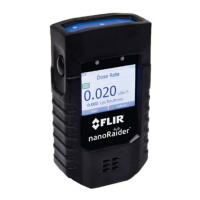D. Glossary FLIR Detection
Background Radiation
The ubiquitous radiation in the environment, emitted from a variety of mostly natural and a
few man-made sources. Natural sources are terrestrial (ÚDecay of ÚRadionuclides like
235
U
or
232
Th abundant in the Earth crust) or cosmic (high-energy ÚProtons originating primar-
ily from the Sun interact with the upper Earth atmosphere creating a shower of secondary
radiation).
Becquerel (Bq)
The becquerel is the ÚSI derived unit of radioactivity. One Bq is deined as the ÚActivity of a
quantity of radioactive material in which one ÚNucleus decays per second. (ÚCurie)
1 Bq =
1
s
Beta Particle
High-energy, high-speed ÚElectrons (𝛽
) or ÚPositrons (𝛽
) emitted as ÚBeta Radiation.
The ÚDecay of ÚNeutrons to ÚProtons emits beta particles and antineutrinos.
Also known as: 𝛽 Particle
Beta Radiation
A ÚParticle Radiation of ÚBeta Particles. Beta Radiation can usually be shielded by a sheet of
metal, for example, Al foil (Figure 245, p. 283). Beta radiation ionizes the surface of organisms
and can lead to severe burns with long-term sequelae like skin cancer.
Also known as: 𝛽 Radiation
Bluetooth
A standardized open wireless technology for data communication over short distances using
radio waves.
Bq ÚBecquerel
(C
2
H
4
)
n
ÚPolyethylene
(C
5
H
8
O
2
)
n
ÚPolymethyl Methacrylate
Cadmium Zinc Telluride (CZT, CdZnTe)
An alloy of cadmium telluride and zinc telluride, a substance to build ÚSemiconductor Radi-
ation Detectors usable at room temperature.
Calibration
A deined procedure for the comparison of the reading of an instrument to the value conven-
tionally accepted as correct (a “standard”).
270 identiFINDER
®
R300/en/2014.4(13623)/Feb2015

